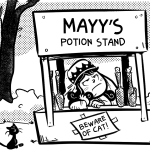Tie Up the Loose Ends: A Writer’s Guide to Sailor’s Knots
by May Haddad
 Knot tying (“nodology” in Latin, “kompology” in Greek) is a time-honored skill honed in seafaring for millennia. Its history intertwines with maritime exploration, naval warfare, and the development of trade routes all over the world. Even as synthetic ropes replaced natural fibers, knots used by sailors centuries ago remain in wide use today. Considering the popularity of “faring” in speculative fiction, whether by sea, sky, or space, featuring knot-tying in your writing is a must for authenticity. Not only are you required to know your knots and how to tie them, but you also need to understand the lingo.
Knot tying (“nodology” in Latin, “kompology” in Greek) is a time-honored skill honed in seafaring for millennia. Its history intertwines with maritime exploration, naval warfare, and the development of trade routes all over the world. Even as synthetic ropes replaced natural fibers, knots used by sailors centuries ago remain in wide use today. Considering the popularity of “faring” in speculative fiction, whether by sea, sky, or space, featuring knot-tying in your writing is a must for authenticity. Not only are you required to know your knots and how to tie them, but you also need to understand the lingo.
In a maritime context, a line refers to rope or cord given a specific purpose on vessels. Lines are used for rescue and safety, mooring the vessel, securing cargo, and in managing overall rigging (including cables and chains, holding together other ship infrastructure).
Cord has a smaller diameter than rope, though both are flexible, twisted, or braided materials. The bitter end of a line is its free end, while the standing end is fixed. To prevent fraying, a line end might be whipped (bound with a small cord), while lashing secures two or more items together with a line. Flemish flake and daisy chain are terms for rope coiled in circular patterns for storage and to prevent kinking. Coiling is another way of storing rope, using loops.
Control lines are for the sails: halyards raise and lower them, while sheets help with angle, shape, and positioning. Mooring lines tie boats to docks, buoys, and other vessels while towing lines allow one vessel to pull another, and anchor lines hold a vessel in place with weights.
Winding rope around itself or other objects creates friction between layers and helps keep knots from slipping or coming undone under tension. Shorting knots, like a sheepshank, remove slack on the line and can bypass a rope’s frayed or damaged sections, but it’s liable to slip if not under tension. A shroud knot also helps with repairs and is used for broken rigging.
Many tasks require flexibility, like securing fenders, adjusting dinghy rowing, making sail adjustments, tenting, and awning. An adjustable loop, like a taut-line hitch, can hold items securely under tension but allow for movement when slack.
To connect two ends of a single line, a binding knot is used. The constrictor is ideal for situations where permanent binding is needed because it securely grips objects it’s tied around but is difficult to untie once tightened. The rope often needs to be cut to be freed. A reef, Hercules, or square knot is ideal for securing rope around objects (usually tying up bundles), but is not considered suitable for joining ropes used for climbing or heavy loads, as it can slip under tension or if the ropes are of different sizes.
Bending knots join two lengths of rope: a sheet bend for ropes of different thicknesses (and a double sheet bend for added strength); a carrick bend (or sailor’s breastplate) for two heavy ropes/cables; an anchor bend (fisherman’s bend) for securing a rope to an anchor; ring bends, tape knots, or water knots for webbing.
Hitching knots secure a rope to an object or other rope. Clove hitches are temporary and versatile, but because they’re liable to slip if not in constant tension or tied to something smooth and round, they’re often used with other knots. Round turn and two half-hitches are ideal for attaching a rope to a pole, ring, or other object where reliability and adjustability matter. The round turn (two wraps around the object) takes most of the load, and the two hitches (simple knots) lock the load in place. Rolling hitches also relieve tension on a line or help handle a load because it can hold well in one direction against the pull and resist sliding lengthwise.
Loop knots make a line more functional. Bowlines create a fixed loop to attach to a post, ring, rope, or body for mooring, docking, towing, rigging, and rescue. Figure-eight loops are non-slip knots ideal for all the above, as well as attaching sheets, creating secure tie-off points on the deck, and certain kinds of rigging. Alpine butterfly knots offer a versatile and very secure mid-rope loop, ideal for multi-directional loads. They’re used for attaching a carabiner or hook or as a tie-in point for securing gear or creating an anchor point.
Stopper knots prevent line ends from slipping through a retaining device. The figure-eight bend knot, also called the Flemish knot, is a variant considered easy to inspect due to its distinctive shape and easy to tie and untie even after being loaded.
Some knots are decorative or ornamental but still functional. Coxcombing protects or identifies items and parts of vessels, while a monkey’s fist is tied at the end of a rope to serve as a weight, making it easier to throw or use as a hand-to-hand weapon (slungshot). A sailor’s knot or Turk’s head marks the “king spoke” of a ship’s wheel (the spoke that is upright when the rudder is in a central position) and can help to tighten or better grip underlying material.
Figuring out when and where to feature knots in speculative fiction is always challenging. In historical fantasy, figuring out what was known at the time and how it was pulled off could require hours of research. In contrast, figuring out the future of the craft and its materials in futuristic science fiction will take some imagination. All of this may seem overwhelming at first, but don’t fret. When you reach the end of your rope, tie a knot in it and hang on!
 May Haddad is an Arab American writer of speculative fiction whose work deals with the Arab experience across time and space and touches on themes of nostalgia, isolation, memory, and longing. As of this publication, you can find her work in The Markaz Review and Nightmare Magazine.
May Haddad is an Arab American writer of speculative fiction whose work deals with the Arab experience across time and space and touches on themes of nostalgia, isolation, memory, and longing. As of this publication, you can find her work in The Markaz Review and Nightmare Magazine.


